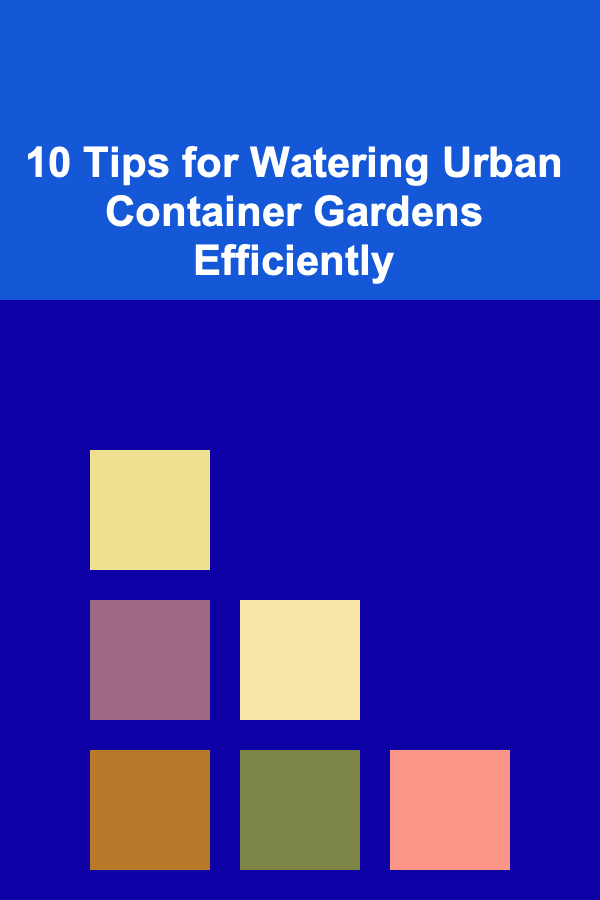
10 Tips for Watering Urban Container Gardens Efficiently
ebook include PDF & Audio bundle (Micro Guide)
$12.99$5.99
Limited Time Offer! Order within the next:

Urban container gardening has gained immense popularity in recent years, especially as city dwellers look for ways to grow their own food in small spaces. Whether you live in an apartment, have a balcony, or have limited outdoor space, container gardening provides an excellent opportunity to cultivate a wide variety of plants. However, one of the challenges of container gardening, particularly in urban settings, is watering. Improper watering techniques can lead to either overwatering or underwatering, both of which can harm your plants. To help ensure your garden thrives, here are 10 practical tips for watering urban container gardens efficiently.
Know Your Plants' Water Requirements
The first step to watering efficiently is understanding the water needs of your specific plants. Not all plants have the same water requirements, and some are more drought-tolerant than others. For example, succulents and cacti need minimal water, while leafy greens like lettuce and herbs like basil require more consistent moisture.
Before watering, consider the type of plants in your containers and their individual needs. Tropical plants like ferns thrive in consistently moist soil, while Mediterranean herbs like rosemary prefer to dry out slightly between waterings. Researching your plants' specific needs will help you create a more tailored watering schedule.
Water at the Right Time of Day
The timing of your watering can greatly affect how efficiently your plants absorb moisture. Watering at the right time ensures that your plants get the hydration they need without unnecessary water loss through evaporation.
- Early Morning: Watering in the early morning allows the plants to absorb moisture before the heat of the day. This helps prevent water from evaporating too quickly and ensures that your plants have enough water to withstand the afternoon heat. Additionally, early morning watering helps prevent fungal diseases that thrive in damp conditions.
- Late Afternoon or Early Evening: If you can't water in the morning, late afternoon or early evening is the next best time. Watering at this time allows the plants to soak in the water without it evaporating too quickly, though it's important to avoid watering too late to prevent the soil from staying too damp overnight.
Avoid watering during midday when the sun is at its hottest, as this leads to excessive evaporation and can cause water droplets on the leaves to act like magnifying glasses, potentially burning the plant.
Use a Proper Watering Can or Hose with a Nozzle
The tool you use for watering plays a key role in ensuring efficient and effective watering. A simple watering can or a hose with an adjustable nozzle gives you better control over how much water is applied to each container.
- Watering Can: A watering can with a fine spout or rose attachment is ideal for gently watering plants in containers. It allows for even distribution of water without disturbing the soil or washing away the surface.
- Hose with Nozzle: If you have multiple containers, a hose with a nozzle that provides a gentle, controlled flow is a great choice. Adjustable nozzles let you choose the right flow rate and pressure for your garden.
Both tools allow you to direct water exactly where it's needed without wasting it or overwatering plants.
Ensure Good Drainage
One of the most common mistakes in container gardening is poor drainage, which leads to waterlogged soil and root rot. To water your containers efficiently, make sure that each one has proper drainage holes. These holes allow excess water to escape, preventing the soil from becoming saturated and promoting healthy root growth.
If you find that your containers don't have drainage holes, consider drilling some yourself or choosing pots that are specifically designed with drainage in mind. Additionally, place a layer of rocks, gravel, or broken pottery at the bottom of your containers to further enhance drainage.
Check Soil Moisture Regularly
Rather than sticking to a strict watering schedule, the best approach is to check the moisture level of the soil in your containers regularly. This ensures that you're only watering when necessary and avoids overwatering. You can check the soil moisture by sticking your finger about 1-2 inches into the soil. If it feels dry at this depth, it's time to water. If it feels damp, wait another day or two before checking again.
Alternatively, you can use a soil moisture meter to get a more accurate reading of the soil's moisture content. This will help you make informed decisions about when and how much to water.
Consider Using Mulch
Mulching is a highly effective technique for conserving moisture in container gardens. A layer of organic mulch, such as shredded leaves, straw, or wood chips, helps retain moisture in the soil by reducing evaporation. Mulch also keeps the soil temperature more stable, protecting plant roots from extreme heat fluctuations.
Apply a thin layer of mulch (about 1-2 inches) to the surface of your containers, ensuring that the mulch doesn't touch the plant stems, as this can cause rot. Mulching also helps prevent weed growth and improves the overall health of the soil.
Water Deeply, Not Frequently
One of the most important aspects of efficient watering is to water deeply rather than frequently. Shallow watering may wet only the surface of the soil, encouraging the plant's roots to stay near the surface, where they are more vulnerable to drought and temperature fluctuations.
Instead, water deeply so that the moisture reaches the plant's root zone. This encourages the roots to grow deeper into the soil, making the plant more drought-resistant. Deep watering also reduces the frequency of watering, as the soil will stay moist for a longer period.
To water deeply, allow the water to soak into the soil slowly. If the water runs off the top of the container too quickly, pause for a minute to let it absorb, then resume watering.
Use a Drip Irrigation System
For urban container gardens, especially those with multiple containers, a drip irrigation system can be a game-changer. Drip irrigation delivers water directly to the base of each plant, ensuring that the roots receive the moisture they need without water waste. This system is highly efficient because it targets the root zone, preventing evaporation or runoff.
A drip irrigation system can be set up with a timer, allowing you to water your plants automatically at a set time and frequency. This ensures consistent moisture levels, making it ideal for those who are busy or often forget to water their plants.
You can install a basic drip irrigation system yourself using tubing, emitters, and a water source. Many garden supply stores offer kits specifically designed for small container gardens.
Use Self-Watering Containers
Self-watering containers are another excellent solution for efficient watering in urban environments. These containers have a built-in reservoir that allows the plant to absorb water as needed, preventing overwatering or underwatering. The design typically includes a wicking system that draws water from the reservoir into the soil, keeping it consistently moist.
Self-watering containers are particularly useful for people who travel frequently or for those who want a low-maintenance gardening option. These containers are available in various sizes and styles, from small window boxes to large planters, making them suitable for almost any space.
Consider Watering Solutions for Hot Weather
In hot urban environments, plants in containers are especially vulnerable to dehydration, as they are exposed to the elements more directly than plants in the ground. During periods of intense heat, you may need to adjust your watering routine.
- Increase Watering Frequency: In hot weather, container plants dry out faster, so it may be necessary to water them more frequently. Monitor the moisture level of the soil and water as needed to keep the plants hydrated.
- Provide Shade: If possible, provide some shade for your container plants during the hottest part of the day. This can reduce the rate of evaporation and prevent your plants from drying out too quickly.
- Watering with Cool Water: Watering with cool, not cold, water helps prevent the shock that can occur when hot soil meets cold water. Ideally, water should be the same temperature as the surrounding environment.
Conclusion
Watering is a critical aspect of urban container gardening, and efficient watering practices can make all the difference in the success of your garden. By understanding your plants' water requirements, choosing the right tools, ensuring proper drainage, and considering the environmental factors around your plants, you can conserve water and keep your urban garden healthy and thriving. Implementing these 10 tips will help you create a more sustainable and productive garden, ensuring that your plants receive the hydration they need to grow and flourish in an urban environment.
Reading More From Our Other Websites
- [Personal Care Tips 101] How to Combine Face Oil with Your Favorite Serums for Better Results
- [Personal Care Tips 101] How to Use Mouthwash to Soothe a Sore Throat
- [Personal Care Tips 101] How to Enhance Your Hair's Natural Shine with Hair Mousse
- [Personal Care Tips 101] How to Choose a Toothbrush That Fits Your Brushing Style
- [Rock Climbing Tip 101] Beyond the Crag: How Modern Guidebooks Are Shaping the Future of Climbing
- [Tiny Home Living Tip 101] Best Ways to Incorporate Sustainable Heating Systems in Tiny Living Spaces
- [Home Holiday Decoration 101] How to Set the Table for a Holiday Feast with Elegant Decor
- [Scrapbooking Tip 101] Troubleshooting Common Adhesive Problems in Scrapbooking Projects
- [Home Soundproofing 101] How to Soundproof Your Home Using Natural Materials
- [Home Renovating 101] How to Create an Open Floor Plan During Your Home Renovation

How to Deal with Hard Water Stains in Your Bathroom
Read More
How to Improve Tenant Retention in Your Rental Property
Read More
How to Save Money on Utilities and Lower Your Bills
Read More
What Are the Must-Have Items for a Well-Organized Garage?
Read MoreHow to Build a Vendor Payment Tracker in Google Sheets
Read More
How to Read Tarot for Beginners: A Step-by-Step Guide
Read MoreOther Products

How to Deal with Hard Water Stains in Your Bathroom
Read More
How to Improve Tenant Retention in Your Rental Property
Read More
How to Save Money on Utilities and Lower Your Bills
Read More
What Are the Must-Have Items for a Well-Organized Garage?
Read MoreHow to Build a Vendor Payment Tracker in Google Sheets
Read More